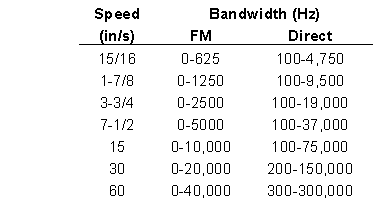Instrumentation recorders were and are widely used in industry, scientific research, and government. The Inter-Range Instrumentation Group (IRIG) helped standardize these.
There are both FM and Direct instrumentation tapes in 1/4-inch formats. These are typically four-tracks, essentially compatible track-wise with audio, but the “direct” recording, while similar to audio, was constant current with no EQ. FM placed a carrier on the tape and modulated the carrier. FM can reproduce changes in DC levels. The response goes to DC. The IRIG standards (IRIG 106) for instrumentation recording can be found here. Chapter 6 Part 1 addresses this type of recording, but appears to bave been dropped in the 2005 version. It is in the 2004 version. This table shows the FM recording parameters. This provides information on the Direct formats and track assignments. As I understand it, the Bruel & Kjaer quarter-inch recorders used their own proprietary systems and speeds of 1.5 and 15 in/s. I have also seen these machines listed as 1.5 and 7.5 in/s.
Half-inch tape has also been used for instrumentation recording with 7 tracks (staggered 3 and 4 track heads). At some point, 14 tracks was also recorded on half-inch tape.
Instrumentation applications put both 14 and 28 tracks on one-inch tape.
Track numbering and layout is a bit more convoluted in instrumentation work than in audio work. There were two widely used transport topologies. One was very similar to an audio recorder, the other reversed the rotation of the reels. This was accomplished, in some designs, by placing the tension rollers at the top of the transport between the reels, forming a loop coming down the centre of the transport, turning around the capstan and going back up. This placed the magnetic coating on the outside of the centre loop.
The IRIG definition for tracks is that the tracks are viewed looking at the magnetic coating with the earlier recorded material at the right. That means the direction of tape travel as you view the tape is left to right. The top edge of the tape held in that orientation is the reference edge and track one is adjacent. If you thread the tape on one of the counter-rotating instrumentation transports, then the reference edge will still be on the top, but when you thread the tape on an audio-like transport, the reference edge will be on the bottom.
While one can often determine which way a tape is wound (heads out: ready to play, or tails out: rewind before playing) from the side of the reel which is labeled, the side of the reel which is labeled in instrumentation may be more of an artifact of which type of recorder topology was used. Instrumentation tape (unlike audio) is usually stored heads out.
For interest’s sake, here are the bandwidth specs of the Racal Store 4DS (which I have) and 7DS portable instrumentation recorders from about 1983.

We acquired our Racal Store 4DS 1/4″ instrumentation recorder in mid-2005 and have both FM and Direct card sets for it. As of July, 2006, we have 1/2″ 7-track direct reproduction working, although our trial run was with low-frequency seismic data. We have not analyzed the high-frequency options yet.
In 2008, we acquired additional instrumentation machines, including a 14-track 1/2-inch version of the Racal Store series. But our very interesting addition is a trio of Honeywell 101 recorders. These take up to 15-inch reels and are in the three major configurations that these recorders were sold in: 1/2-inch 7-track, 1-inch 14-track, and 1-inch 28 track. Apparently, at some point, 42-track 1-inch IRIG recorders were made.
The Honeywell 101s run from 15/16 in/s to 120 in/s and have 1 MHz bandwidth at 60 in/s (higher than the Racal shown in the above table. We can handle (with some limitations) Intermediate Band, Wideband I, and Wideband II tapes with these machines.
Resources for transfer: Richard L. Hess, Aurora, Ontario — We’re looking for more resources who can transfer these tapes. Please contact us to be listed.